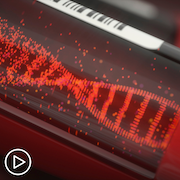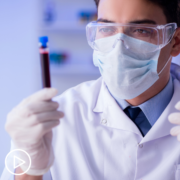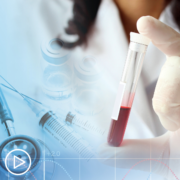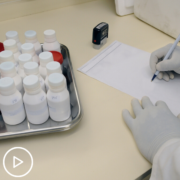What Tests Should CLL Patients Insist They Receive?
What Tests Should CLL Patients Insist They Receive? from Patient Empowerment Network on Vimeo.
Which chronic lymphocytic leukemia (CLL) tests are most critical in CLL care? Dr. Jennnifer Woyach details the key tests, what the tests identify, and how they help provide optimal care personalized to each patient.
Dr. Jennifer Woyach is a hematologist-oncologist specializing in chronic lymphocytic leukemia (CLL) at Ohio State’s Comprehensive Cancer Center – James Cancer Hospital & Solove Research Institute. Find out more about this expert here.
Related Resources

|

|

|
Transcript:
Katherine:
The goal of this program, Dr. Woyach, is to provide the confidence and tools for patients to advocate for the essential tests to get the best care personalized to them. Are there specific tests that patients should make sure they have?
Dr. Woyach:
Yeah. In CLL, I would say there are three that are very, very important before starting treatment. The first is something called the IGHV mutational status.
What that is defined as is the changes in the variable region of the immunoglobulin heavy chain. That’s a big mouthful that doesn’t mean a lot to most people. So, I’ll give you just a little background on what that really means biologically and then, what that means clinically. So, every B lymphocyte, so a normal B lymphocyte and a CLL cell, has receptors on the surface of the cell that allow it to interact with the environment. And in a normal B lymphocyte, this is really important for the immune system. So, bacteria, virus, something is in the body and the B cell surface receptor is going to be able to recognize that that’s not supposed to be there and then, do something about it.
In CLL, the surface receptors don’t do a lot of interacting with the outside environment but they’re still present there. And in a normal B cell development, the B cells are initially formed in the bone marrow.
And at the time that they’re formed, every one of those receptors is exactly the same. So, we can do DNA sequencing on those receptors and you’ll see that every one is identical. So, during a normal development of a B cell, it undergoes this process that’s called somatic hypermutation, which is where those receptors mutate or change. And that’s important because then, they can recognize different things. And so, you end up with this whole repertoire of thousands or millions of B cells that all are a little bit different and can recognize something different.
So, CLL cells, they’re all clonally related to each other. They’re all going to have the same receptor on their surface. And about 60 percent of the time that receptor is different than the newly born B cells. And so, this is probably a little bit more simplistic than it actually is. But the way we think about that is that those B cells or those CLL cells, which we call mutated because they underwent that mutational process, we think that that means that they come from a more mature initiating cell.
And they tend to be less aggressive, more slow growing. The other 40 percent of patients, if you look at the receptor on their surface, it’s exactly the same as the new B cells in the bone marrow. And we call those IGHV unmutated because they haven’t done that mutational process. And they behave very differently. So, in mutated CLL, only about half of people will ever need therapy in their lives. An average time from diagnosis to first treatment is about 10 years. In contrast to those patients who have unmutated IGHV, basically, all of those people will need therapy at some point in their lives. And average time from diagnosis to first treatment is about three years.
So, you can see how it really breaks people up into two very different categories of disease.
So, that’s the first test and one that’s really important. That’s also one that doesn’t change during the course of the disease. So, if somebody is diagnosed with mutated CLL, it’s always mutated. So, the next marker that’s important is, actually, chromosome changes. So, we know that there are a few different recurrent chromosome abnormalities in CLL that are common and important prognostically. So, one of these is a deletion of part of chromosome 13. It’s called a 13q deletion. It indicates, again, very slow-growing CLL. Patients how have normal chromosomes also are very good disease biology.
Some people have an extra copy of chromosome 12. That’s called trisomy 12, and that’s an intermediate marker. And then, there are two markers that are associated with a little bit more aggressive CLL. One is a deletion of proto chromosome 11. That’s called an 11q deletion.
And the other one is a deletion of proto chromosome 17 called a 17p deletion. These are all abnormalities that are important to test for. And the way that we test for these is something called FISH testing. And FISH stands for fluorescence in situ hybridization. And it’s a way to use an antibody to look for specific abnormalities in the CLL cells. So, that’s important. And another thing that can be done at specialized centers is something called stimulated cytogenetics. So, I mentioned to you with FISH testing, we’re looking for specific abnormalities with antibodies. But the things that we don’t test for we’re not going to see.
So, if they have a chromosome change that we don’t have an antibody looking at, we’ll never detect it. And we know that patients with CLL who have what’s called a complex karyotype, which is three or more chromosome abnormalities, they also have more aggressive disease.
So, like I said, at specialized centers, we can do what’s called a stimulated karyotype, which is where we look at all of the chromosomes. So, that’s FISH testing and karyotype. And then, the last thing is, actually, doing DNA sequencing for a specific mutation called a TP53 mutation. And TP53 is an important tumor suppressor protein. And it is mutated quite commonly in CLL. About 8 to 10 percent of patients at the time of first treatment and, actually, up to about 40 percent of people later on in the course of the disease. Most of the time, we see TP53 mutations occur at the same time as 17p deletions. About 80 percent of the time, those occur together but they can occur on their own.
So, that’s the third test that’s often helpful, especially prior to starting treatment.
Katherine:
Do patients need to be retested over time?
Dr. Woyach:
Yeah. So, for the TP53 mutation and for FISH, it’s important to test for those before each line of therapy. Because those are so important in indicating disease biology and, specifically, with the 17p deletion and TP53 mutation, those indicate patients that are likely to not have as good of a response to treatment. It’s always important to check for those prior to therapy.










